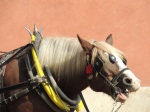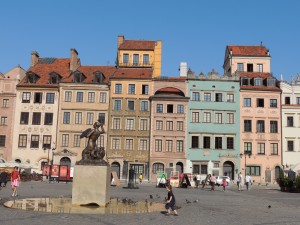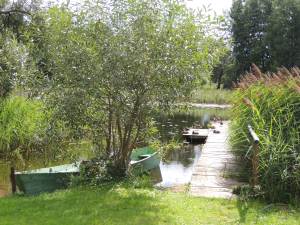Judi excavates a weighty Lonely Planet guidebook from her pack, and we make a plan. And then, a revised plan. And another until we are ready to hit the streets for our first days in Moscow.
 It’s Sunday. The first Fall rains drizzle in our faces and steadily soak our clothes. Deep in the subways, families are the crowds. Romantic couples turn to face each other, hugging while travelling the steep escalators. At the Revolutionary station, two bronze dogs hold their noses high as passers-by reach to pet them for good luck. The dogs’ noses are shined bright gold from the attention.
It’s Sunday. The first Fall rains drizzle in our faces and steadily soak our clothes. Deep in the subways, families are the crowds. Romantic couples turn to face each other, hugging while travelling the steep escalators. At the Revolutionary station, two bronze dogs hold their noses high as passers-by reach to pet them for good luck. The dogs’ noses are shined bright gold from the attention.
Our destination is Vernissage/Izmailova, Moscow’s outdoor market. Vendors sell Russian handcrafts and antiques within a market situated in the shadow of a faux facade of the Kremlin. Along the sidewalk that approaches the market, honey sellers compete with each other for attracting buyers. Misdirected hornets also are attracted. They mire in the honey vats, skimming across the sticky surface with great difficulty on their paddling legs.
 A handsome bbq chef in a white jacket calls for us to try the smoked salmon or lamb or chicken or beef kabobs. There are tables with benches to share with other market-goers. The tables are welcoming in their alcoves with shelter from intermittent rain. Our benchmates are a friendly couple who gesture to us to take a picture with the chef. We secure the offered souvenir after Judi joins the smiling chef on the business side of the red coals at his grill. He hands her an “arrow” of meat, as the menu deftly describes in English, to use as a photo prop. We hope he got a deal on his white coat -It reads, “Medical” in crisp, blue script )!).
A handsome bbq chef in a white jacket calls for us to try the smoked salmon or lamb or chicken or beef kabobs. There are tables with benches to share with other market-goers. The tables are welcoming in their alcoves with shelter from intermittent rain. Our benchmates are a friendly couple who gesture to us to take a picture with the chef. We secure the offered souvenir after Judi joins the smiling chef on the business side of the red coals at his grill. He hands her an “arrow” of meat, as the menu deftly describes in English, to use as a photo prop. We hope he got a deal on his white coat -It reads, “Medical” in crisp, blue script )!).
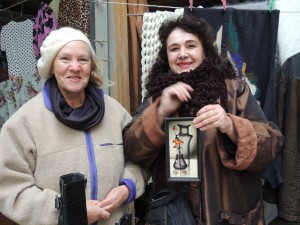 The antique vendors assemble on the weekends. The antiques are a varied lot which resemble the hodgepodge of a house sale. One particularly nice find is an air-brushed print that is about 40 years old. The seller introduces her friend who says that she was once an Engish teacher. She observes that the artists who worked on poster propaganda also made domestic, decorative prints on their own such as the one in hand. They used the same layering, screening technique. We agree that the artistic urge cannot be confined by prevailing politics.
The antique vendors assemble on the weekends. The antiques are a varied lot which resemble the hodgepodge of a house sale. One particularly nice find is an air-brushed print that is about 40 years old. The seller introduces her friend who says that she was once an Engish teacher. She observes that the artists who worked on poster propaganda also made domestic, decorative prints on their own such as the one in hand. They used the same layering, screening technique. We agree that the artistic urge cannot be confined by prevailing politics.
I was drawn to a cobalt blue porcelain cup with a Lomonosov mark. This factory became famous in St Petersburg during Catherine the Great’s reign. The seller said it came to Moscow from a Siberian household. Good lord, it made it this far…I hope it will make it to south Florida. That was the deciding moment when I became not only a traveller, but a luggage juggler of fragile things.
After mingling with home arts at the fair, we search out classical Russian art at the dignified Tretyakov / National Gallery of Art. Russian masterworks are glorious throughout the collection which particularly features 19th C. painting. This proud exhibition of Russian, cultural accomplishment seems like an effete chest pounding for touting Russian artistic prowess. Praise is well earned, but the narrative says most by omission. Nowhere do the Gallery curators attribute any influence of European Impressionism, Cubism, or other international and visibly influential art schools on the Russian masters. It is as if the Russian painting tradition had a virgin birth, and appeared by miraculous inspiration here at the Tretyakov.

Reply of the Zaporozhian Cossacks to Sultan Mehmed IV of the Ottoman Empire, 1880–91 (State Russian Museum).
I can forgive such a revisionist view of art history. Especially after visiting the work of Ilya Repin, a jovial sort of painter whose wit, manliness, psychological studies, and philosphy rival the same attributes found in the literary works of Ernest Hemingway.


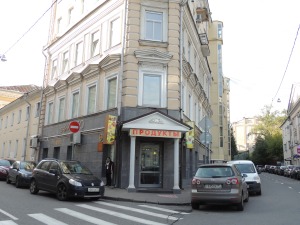









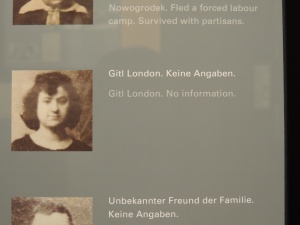

 photo (c) BBC
photo (c) BBC